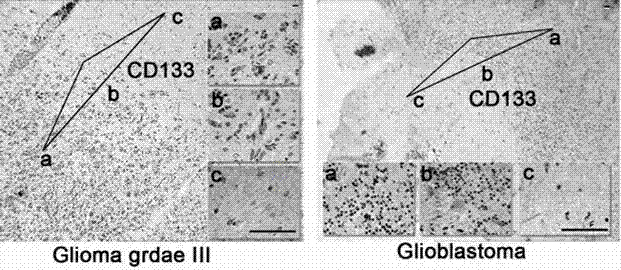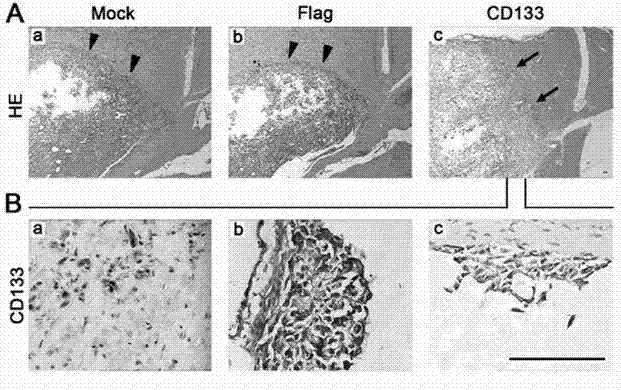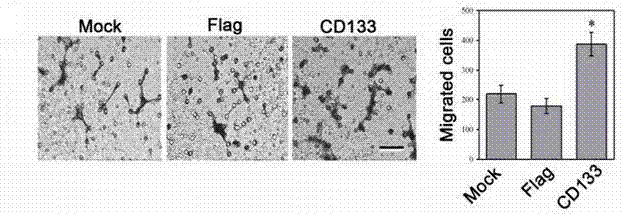Use of CD133 in preparation of tumor marker and kit of CD133
A tumor marker and kit technology, applied in the field of molecular biology and tumor drugs, can solve problems such as no discovery effect
- Summary
- Abstract
- Description
- Claims
- Application Information
AI Technical Summary
Problems solved by technology
Method used
Image
Examples
Embodiment 1
[0057] The C57 mouse orthotopic model of GL261 was constructed with luciferase-labeled GL261 mouse glioma cells, and the tumor growth was dynamically detected by live imaging of small animals. Using mouse glioma model and human malignant glioma specimens, CD133 (CD133-Flag sequence is shown in SEQ ID NO 1, and its luciferase sequence is shown in SEQ ID NO 2) was detected by immunohistochemistry in glioma, glial The junction of glioma and normal tissue and the expression characteristics and differences in normal tissue. The results showed that the glioma invaded the normal brain tissue area obviously. CD133 immunohistochemical staining of brain slices showed that CD133 was highly expressed in the tumor invasion area, while CD133 was less expressed in the tumor and normal brain tissue. The same results were also verified in human glioma specimens. CD133 immunohistochemical staining of 18 glioma specimens with junctional tumor and normal tissue showed that the expression of CD1...
Embodiment 2
[0061] A plasmid expressing CD133 was constructed, and CD133 was overexpressed in the above two glioma cells. Using the C57 mouse model of GL261 and the U87 nude mouse model, the border of tumor formation, the number of daughter tumors, the invasion of the corpus callosum and the spread of the ventricles were observed after CD133 overexpression. The results showed that the tumors formed in the Mock and Flag groups had smooth edges, while the tumors in the CD133 group showed high invasiveness, showing obvious invasion to normal brain tissue, and a large amount of cerebrospinal fluid dissemination and planting. These disseminated foci were all CD133+, suggesting that they were all derived from exogenous CD133 cells. The same phenomenon as above was observed in the U87-GFP and U87-CD133-GFP nude mouse models, that is, the tumor invasiveness of the CD133 group was significantly stronger than that of the Flag group, and a large number of daughter tumors were formed in the CD133 gro...
Embodiment 3
[0065] Using GL261 and U87 glioma cells overexpressing CD133, the expression of CD133 was further analyzed by Transwell model, flow cytometry detection of cell cycle, gelatin zymography test, cell adhesion test, in vitro scratch test and cytoskeleton protein F-actin staining. Role in glioma invasion.
[0066] The results of Transwell invasion assay showed that the number of invasive cells in the CD133 group was significantly more than that in the Mock and Flag groups, suggesting that CD133 can significantly promote the invasion of GL261 glioma cells in vitro. There was no statistical difference in the cell cycle distribution of the three groups of cells, which ruled out the influence of the cell cycle on the results of the Transwell invasion assay. The results of MMP zymography experiments indicated that there was no difference in the activities of MMP-2 and MMP-9 among the three groups of cells, indicating that CD133 had no significant effect on the ability of glioma cells to d...
PUM
 Login to View More
Login to View More Abstract
Description
Claims
Application Information
 Login to View More
Login to View More - R&D
- Intellectual Property
- Life Sciences
- Materials
- Tech Scout
- Unparalleled Data Quality
- Higher Quality Content
- 60% Fewer Hallucinations
Browse by: Latest US Patents, China's latest patents, Technical Efficacy Thesaurus, Application Domain, Technology Topic, Popular Technical Reports.
© 2025 PatSnap. All rights reserved.Legal|Privacy policy|Modern Slavery Act Transparency Statement|Sitemap|About US| Contact US: help@patsnap.com



